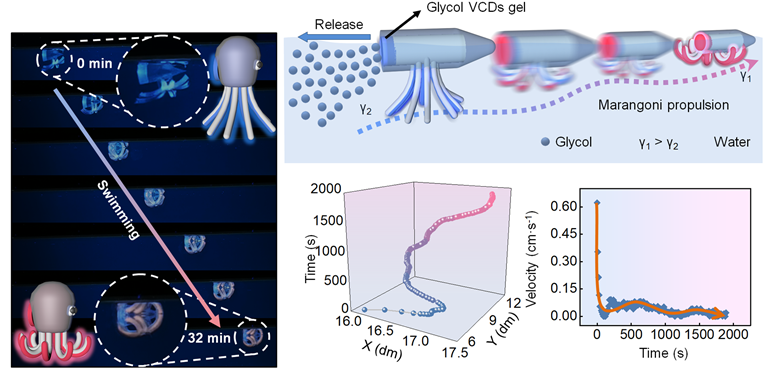Prof. CHEN Tao’s team at the Ningbo Institute of Materials Technology and Engineering (NIMTE) of Chinese Academy of Sciences (CAS) developed the aggregation induced emissive (AIE) carbon dots (CDs) glycol gel, which facilitates the realization of powerful octopus-like soft robots with synergistic multi-functionalities. The study was published in Angew. Chem. Int. Ed.
Marvelous multi-function synergistic behaviors of natural systems for communication, disguise and self-protection, have attracted great attention of worldwide researchers. Much effort has been put on the replication of these multi-function synergistic behaviors via artificial soft materials, especially soft wet polymer gels with biotissue-like mechanical properties. However, it is still challenging to construct multifunctional soft robots with complex synergistic shape/color change and directional locomotion behaviors.
Inspired by the threat perception of octopi, researchers at NIMTE utilized unique hydrophobic CDs with rotatable surficial groups to construct the AIE-active glycol CDs polymer gel. The glycol gel layer was further interfacially bonded with an elastomer layer to construct a bilayer soft actuator.
When the actuator was put on the water surface, glycol spontaneously diffused out from the gel layer to allow water intake, resulting in a blue-to-red color change and a shape deformation. Meanwhile, a large surface tension gradient was produced, promoting its swimming locomotion.
Employing eight glycol vinyl-functionalized CDs (VCDs) gel bilayer actuators as the “octopus claws” and one single glycol VCDs gel as the “octopus funnel”, researchers successfully prepared an octopus-inspired swimming robot with synergistic shape deformation, color change and directional swimming motion.
The developed CDs gel swimming robot with tri-function synergy has shed light on the design and further improvement of multi-functional bio-inspired intelligent soft robots.
This research was supported by the Natural Science Foundation of China (Nos. 221774138, 52073297 and 51773215), the Sino-German Mobility Program (No. M-0424); Key Research Program of Frontier Sciences, Chinese Academy of Sciences (No. QYZDB-SSW-SLH036), Youth Innovation Promotion Association of Chinese Academy of Sciences (No. 2019297), and K.C.Wong Education Foundation (No. GJTD-2019-13).

Fig. The synergistic shape/color change and directional swimming locomotion of the CDs polymer gel-based octopus-like soft robot (Image by NIMTE)
Contact
WU Shuangshuang
Ningbo Institute of Materials Technology and Engineering
E-mail: wushaungshuang@nimte.ac.cn

